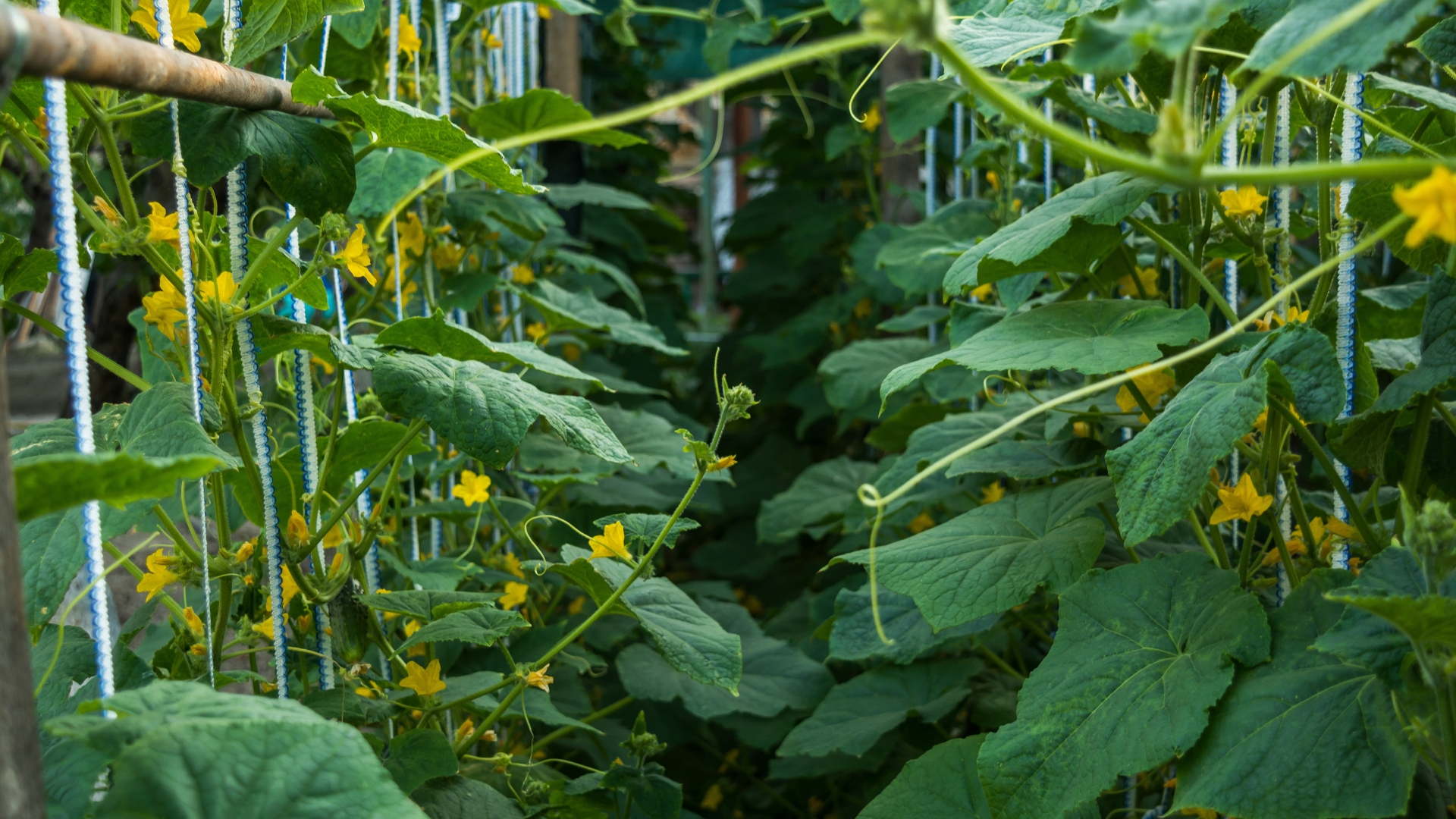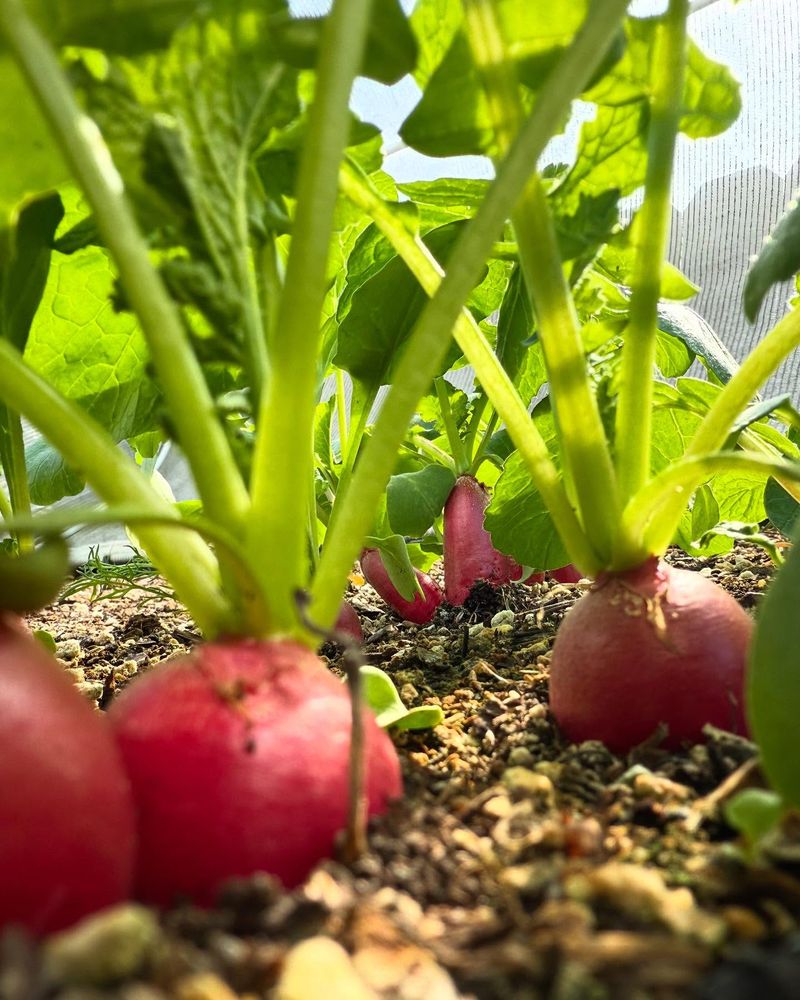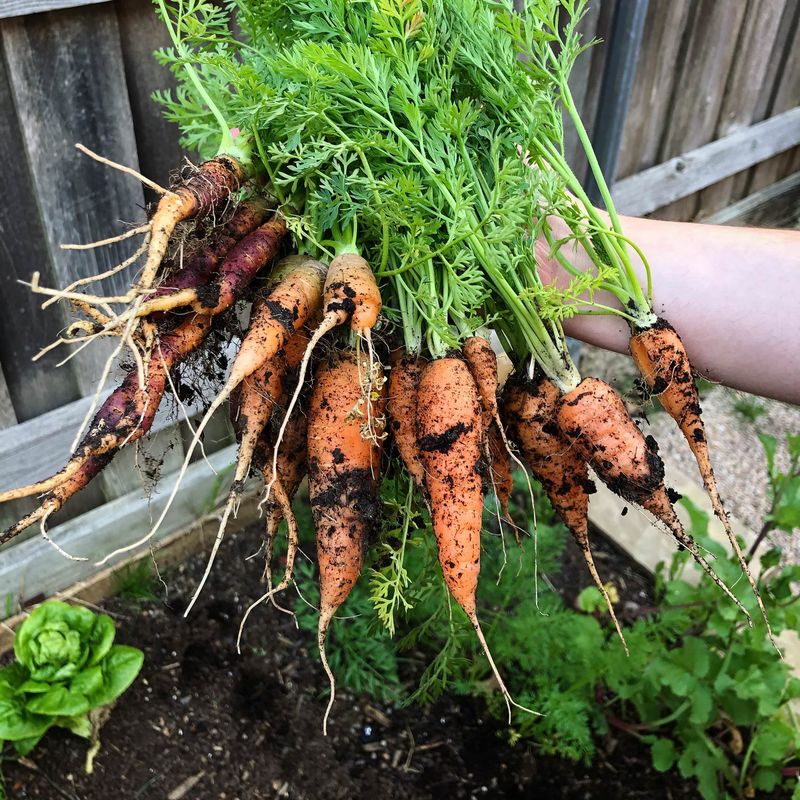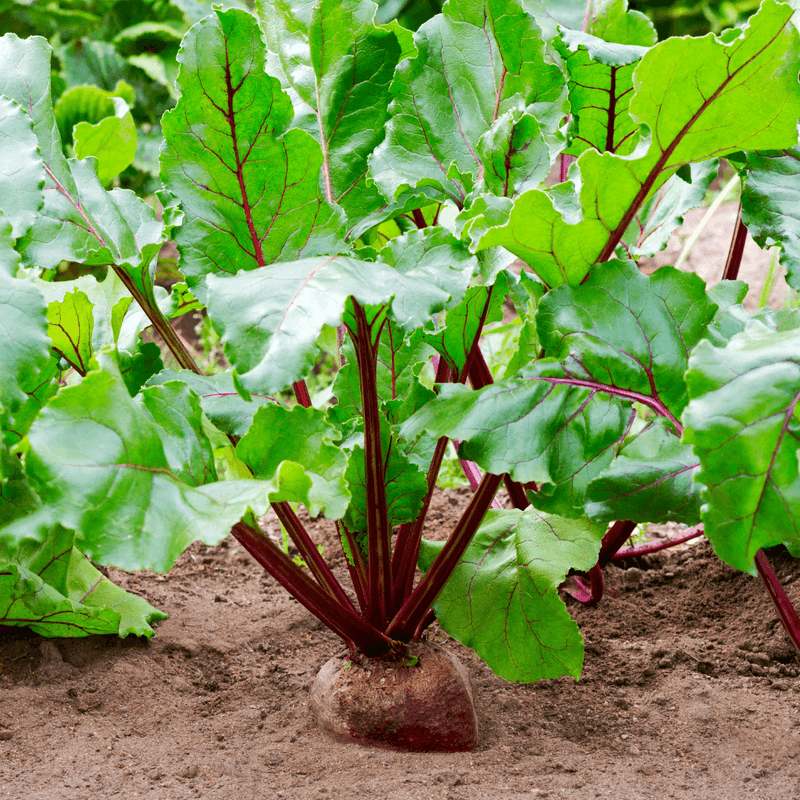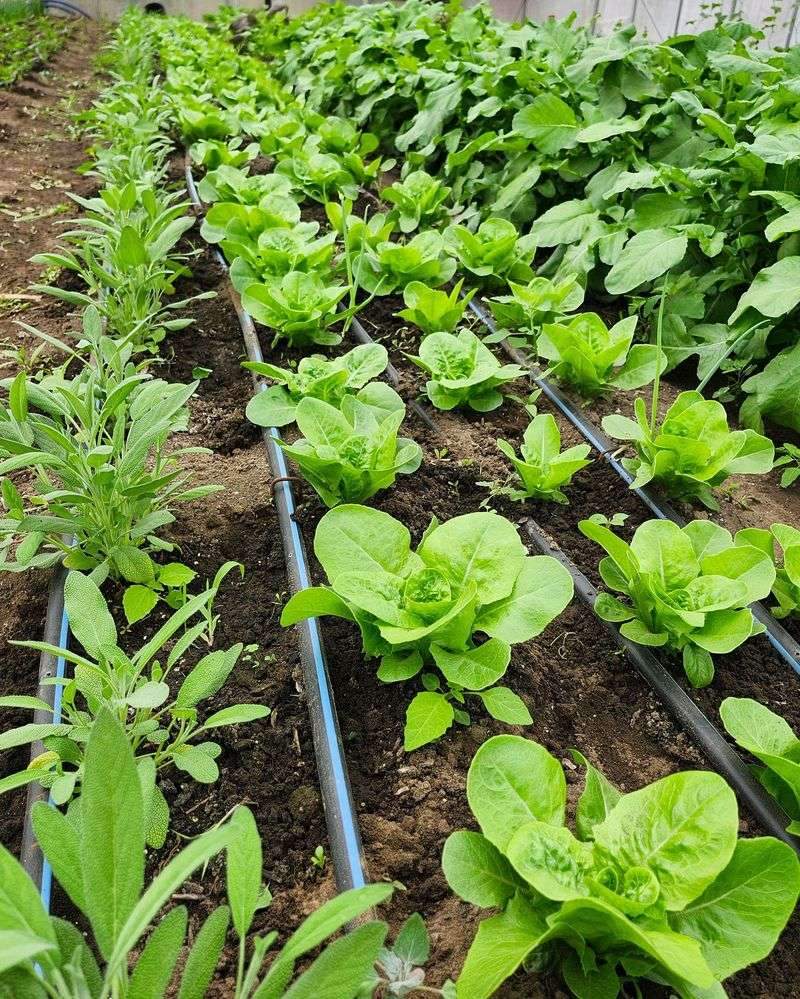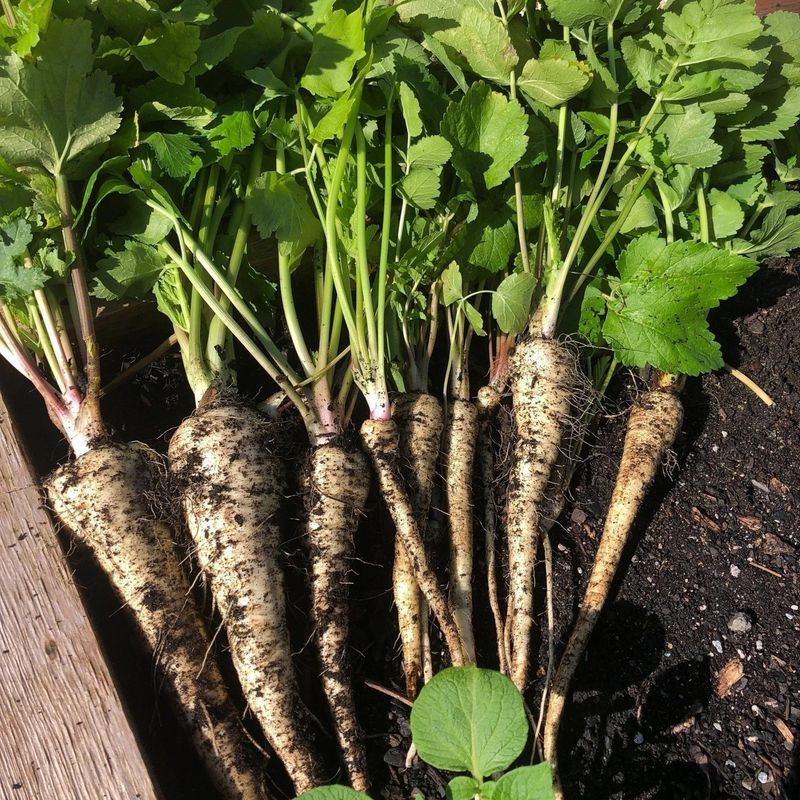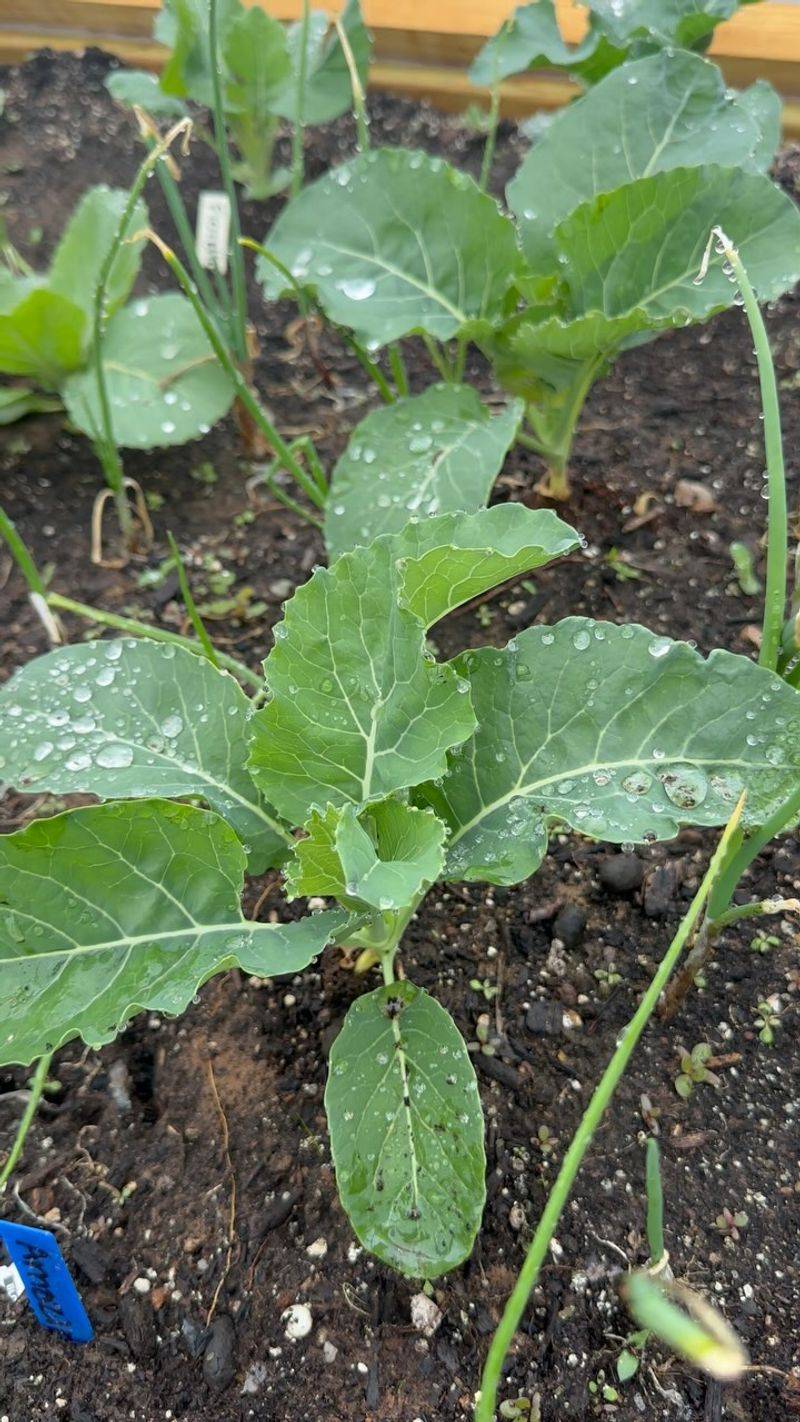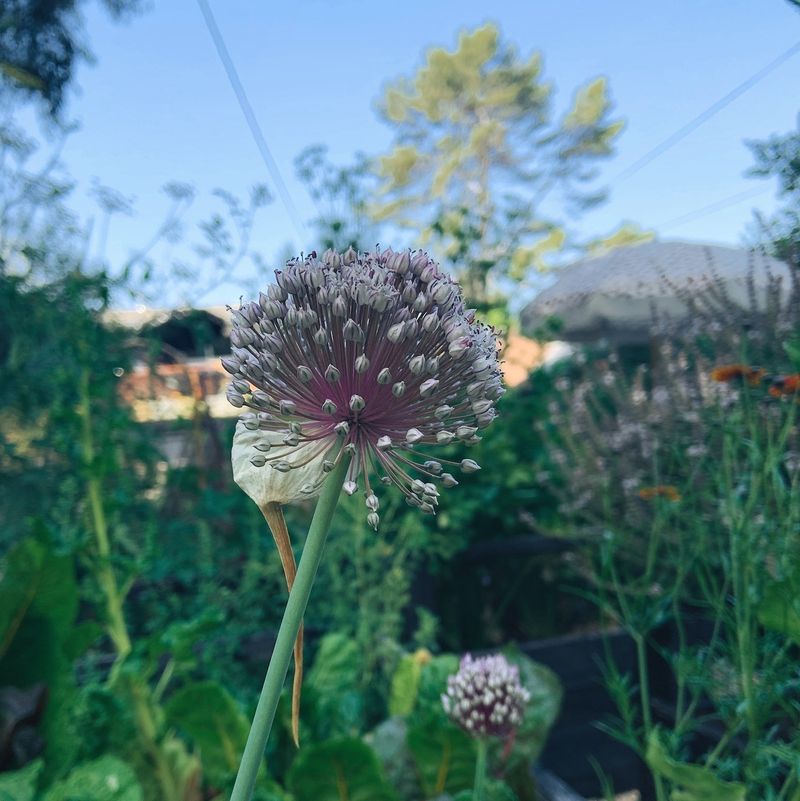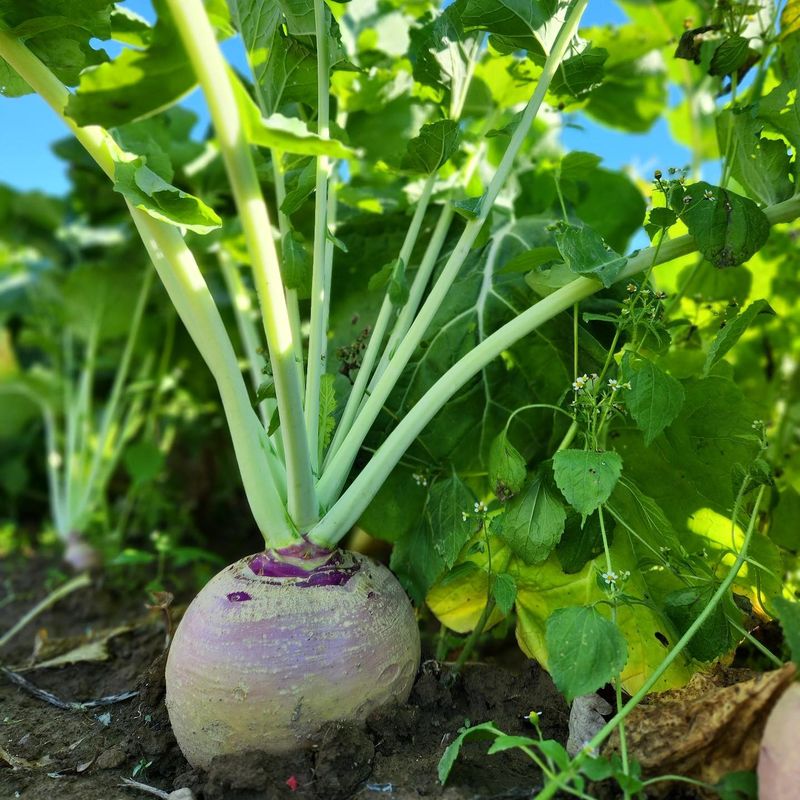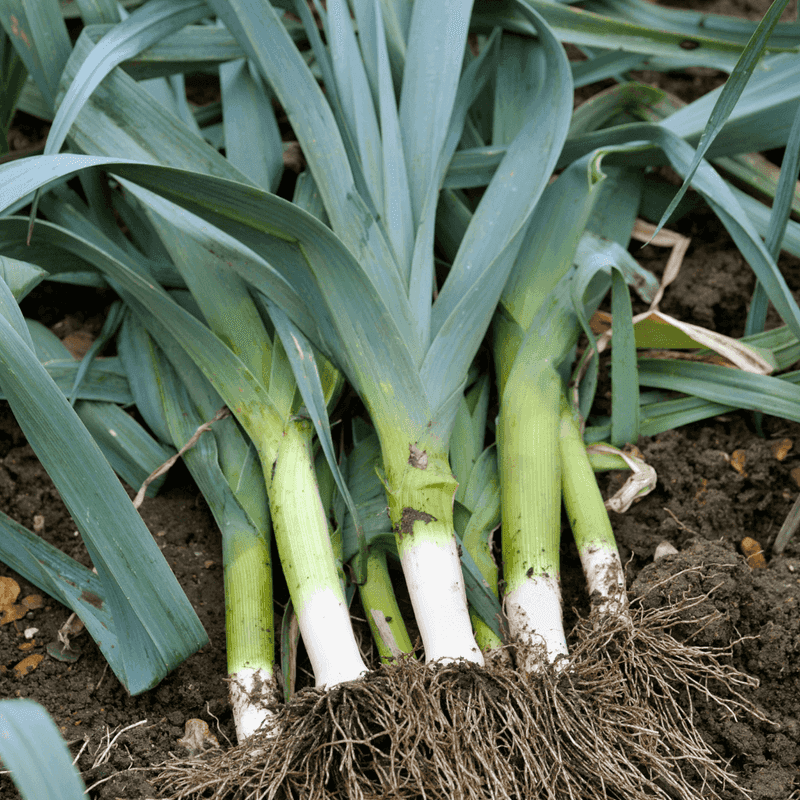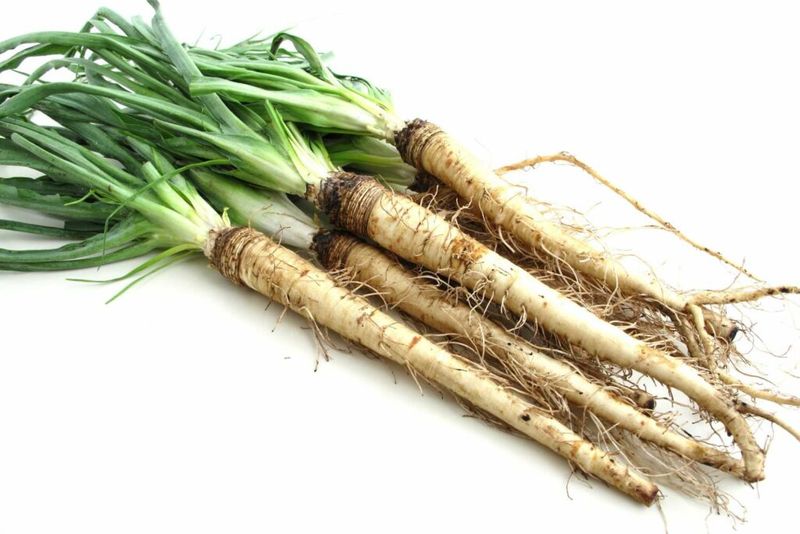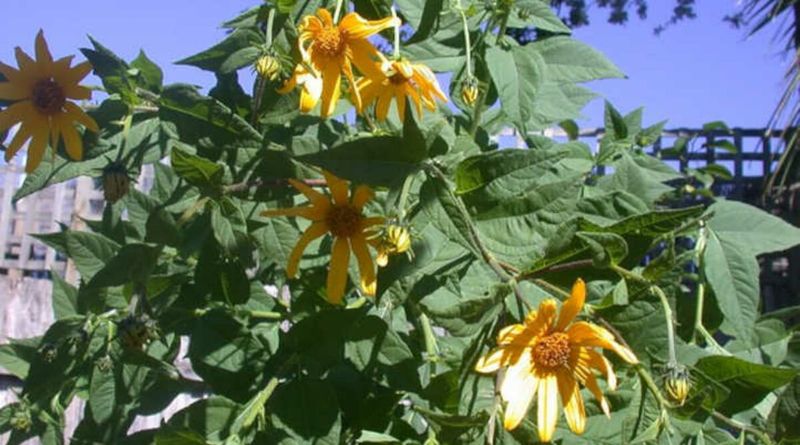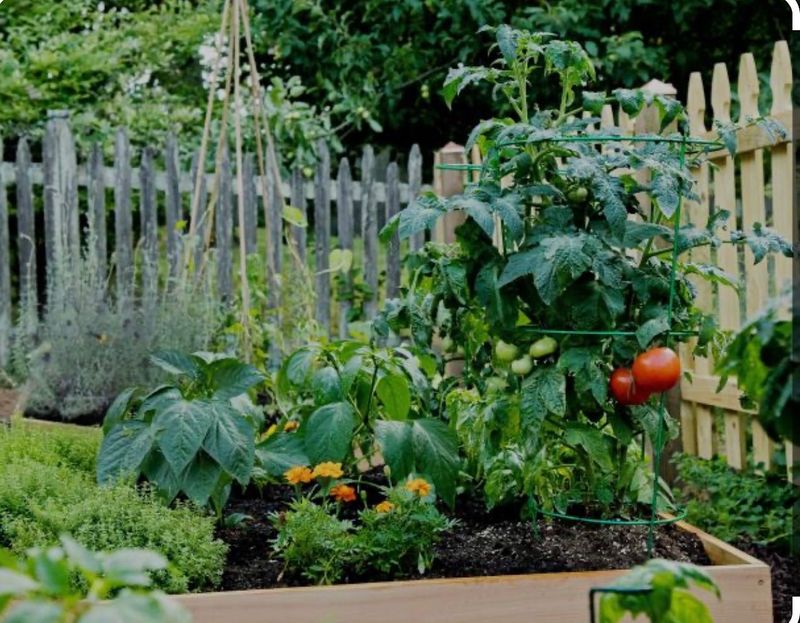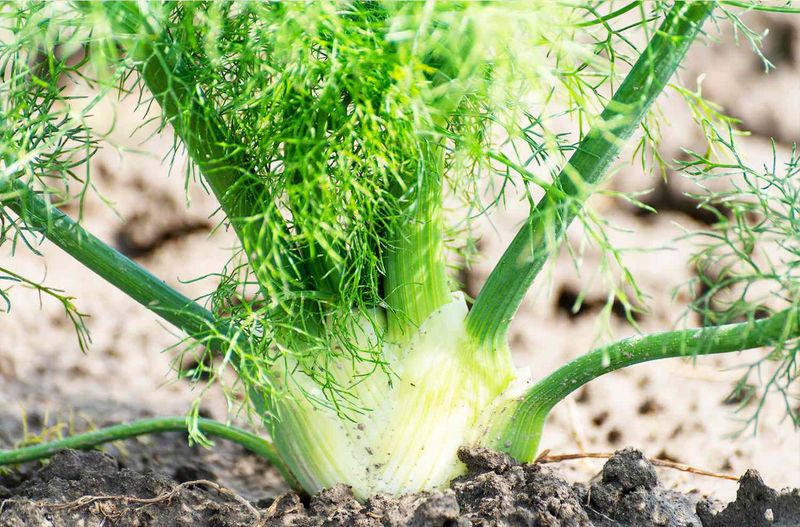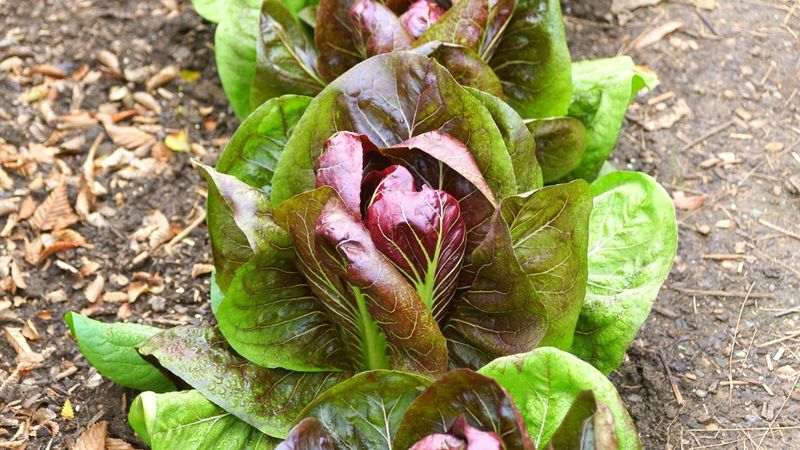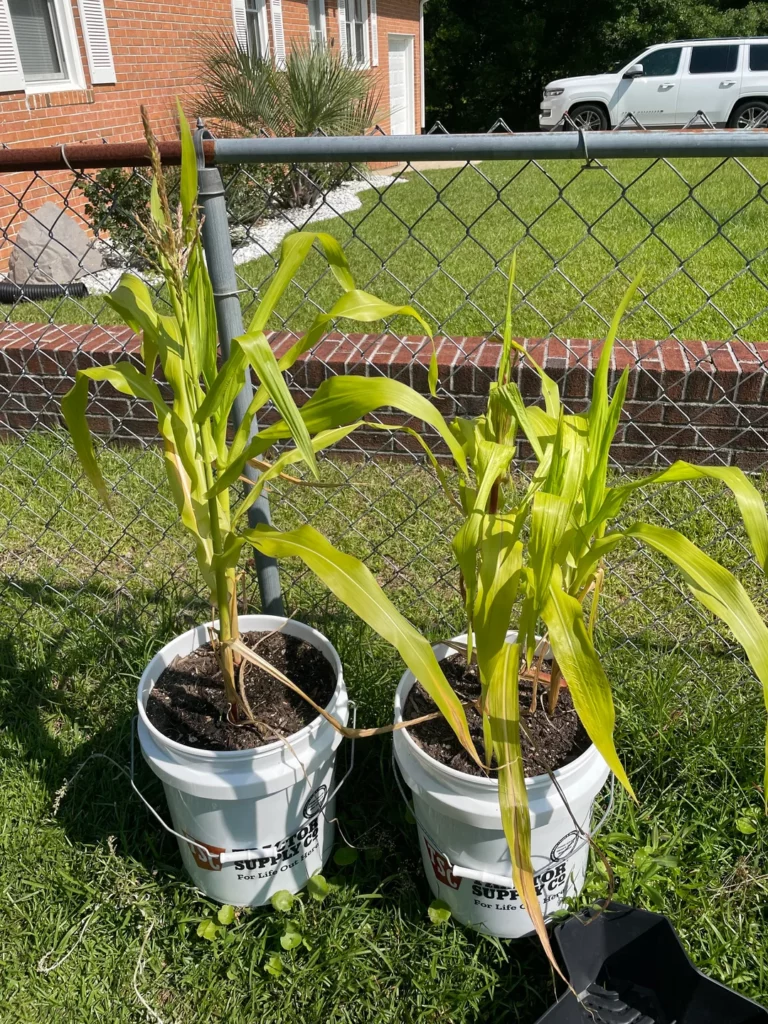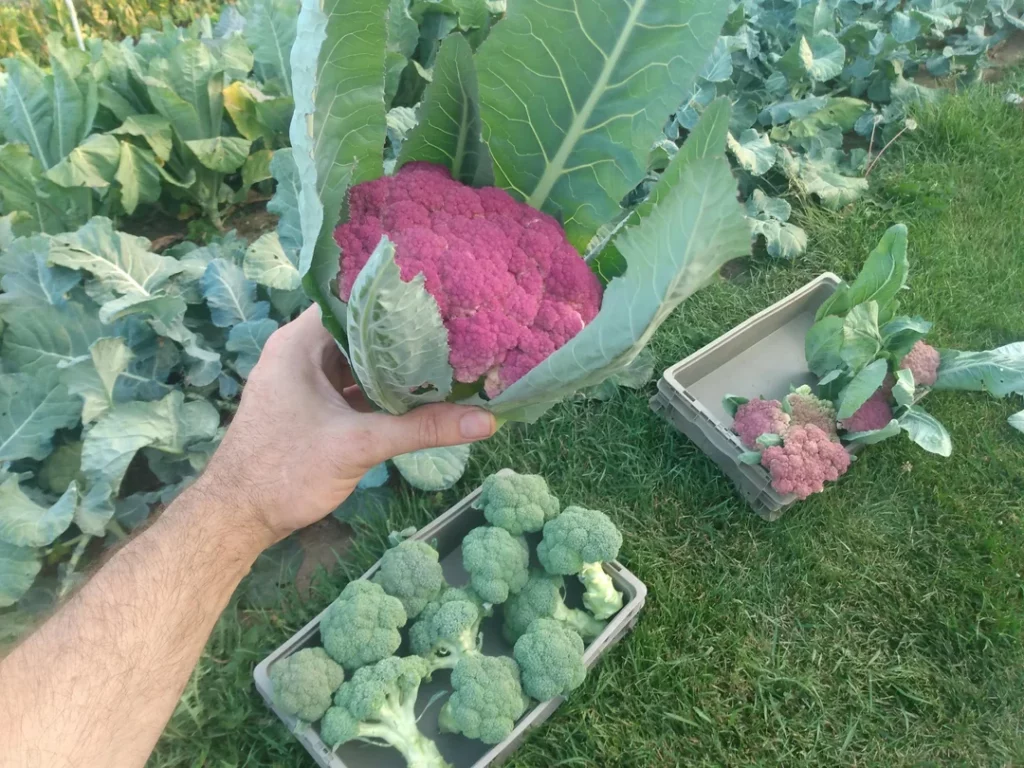Cucumbers can be a bit picky about their neighbors in the garden, and picking the right root veggies to plant nearby can make all the difference. Some root vegetables actually boost cucumber growth, giving you bigger, tastier harvests.
But not all roots play nice—there are a few that can slow your cucumbers down or cause trouble. I’ve put together a list of 14 root veggies that will be cucumber’s best friends and 5 that are better off growing far away.
Let’s get your garden thriving with the perfect root companions!
1. Radishes – Quick-Growing Friends
Radishes mature in just 3-4 weeks, making them perfect cucumber companions. Their quick growth cycle means you’ll harvest them before your cucumber plants need the extra space.
The peppery root vegetables actually help deter cucumber beetles and other pests that might damage your cucumber crop. As a bonus, radishes break up compacted soil with their roots, creating better growing conditions for nearby cucumber plants.
2. Carrots – Deep-Rooting Allies
Growing carrots alongside cucumbers creates a mutually beneficial relationship in your garden patch. These orange root vegetables grow downward while cucumber roots spread horizontally, preventing competition for nutrients and space.
Carrot tops provide light shade for cucumber roots, helping maintain soil moisture during hot weather. Many gardeners report that cucumbers grown near carrots develop a sweeter flavor profile, though the science behind this remains somewhat mysterious.
3. Beets – Colorful Companions
Vibrant beets create a stunning visual contrast while providing practical benefits as cucumber companions. Their broad leaves offer partial ground cover that helps suppress weeds without overshading the cucumber plants.
Both plants thrive in similar soil conditions but feed at different soil depths. Beets extract nutrients from the middle soil layer while cucumbers primarily feed from the top few inches, creating a harmonious growing environment where neither steals resources from the other.
4. Turnips – Pest-Distracting Neighbors
Turnips serve as excellent cucumber companions by acting as trap crops for common garden pests. Flea beetles and aphids often prefer turnip leaves over cucumber foliage, naturally protecting your cucumber harvest.
The root vegetables grow quickly and can be harvested before cucumbers reach their full sprawling potential. Their shallow root systems don’t interfere with cucumber roots, and their broad leaves provide gentle shade that helps keep soil cool and moist during summer heat.
5. Parsnips – Long-Season Partners
Pale and sweet parsnips develop slowly underground while your cucumber plants flourish above. Their different growth patterns mean they won’t compete for the same resources or space in your garden beds.
Parsnips’ deep taproots help break up compacted soil layers, improving drainage and aeration that benefits nearby cucumber plants. The two crops have complementary growing seasons – cucumbers thrive in summer heat while parsnips improve in flavor after exposure to cold, making them perfect succession companions.
6. Onions – Aromatic Protectors
Pungent onions naturally repel many cucumber pests through their strong sulfur compounds. The scent confuses and deters cucumber beetles, aphids, and other insects that might otherwise damage your cucumber crop.
Space-efficient onions grow vertically with minimal spread, allowing cucumber vines plenty of room to sprawl nearby. Their shallow root systems occupy different soil zones than cucumber roots, preventing competition for nutrients and water while maximizing your garden’s productivity.
7. Garlic – Disease-Fighting Bulbs
Garlic’s natural fungicidal and antibacterial properties help protect cucumber plants from common diseases. The pungent bulbs release compounds that suppress harmful pathogens in the soil surrounding your cucumber roots.
Fall-planted garlic is usually ready for harvest just as cucumber vines hit their summer stride. Their vertical growth habit means they take up minimal space while providing maximum benefits to neighboring plants. Many gardeners report fewer instances of powdery mildew on cucumbers grown near garlic.
8. Sweet Potatoes – Ground-Covering Helpers
Sweet potato vines create a living mulch around cucumber plants, suppressing weeds and keeping soil cool. Their sprawling growth habit complements vertical-growing cucumbers when trained on trellises.
Unlike many companions, sweet potatoes thrive in the same warm, fertile conditions as cucumbers. The root vegetables draw nutrients from deeper soil layers than cucumbers, preventing competition. Their dense foliage helps retain soil moisture and reduces watering needs during hot summer months.
9. Rutabagas – Cold-Weather Followers
Hardy rutabagas make ideal succession plants after cucumber season winds down. Plant rutabaga seeds near cucumber plants in mid-summer, and they’ll continue growing long after cucumber production ends.
These purple-topped root vegetables benefit from the nitrogen left behind by cucumber plants. Their deep roots help break up compacted soil for next season’s garden. Many gardeners find the mild, sweet flavor of rutabagas grown after cucumbers is superior to those grown in isolation.
10. Leeks – Vertical Space-Savers
Slender leeks grow straight upward, occupying minimal horizontal space while cucumber vines spread outward. Their complementary growth patterns make efficient use of garden real estate.
The mild alliums deter many cucumber pests through their subtle aroma, particularly cucumber beetles. Leeks’ shallow roots don’t compete with cucumber root systems. As a bonus, many gardeners report that cucumbers grown near leeks develop exceptional crispness and flavor.
11. Horseradish – Perennial Protector
Spicy horseradish roots release compounds that help cucumber plants resist common diseases. The perennial root vegetable contains natural fungicidal properties that can suppress soil-borne pathogens affecting cucumbers.
Plant horseradish at the corners of your cucumber patch rather than interplanting directly. Its deep root system improves soil structure without competing with cucumber roots. As a bonus, horseradish’s tall leaves provide light afternoon shade that protects cucumbers from intense summer sun.
12. Salsify – Uncommon Companion
Often overlooked in modern gardens, salsify makes an excellent cucumber companion with its deep taproots and minimal foliage. Also called the oyster plant, salsify grows vertically without spreading, leaving plenty of room for cucumber vines.
The root vegetable’s growth cycle complements cucumbers perfectly – it grows slowly during cucumber season and continues developing after cucumber plants decline. Salsify’s delicate foliage doesn’t shade cucumber plants, ensuring they receive maximum sunlight for fruit production.
13. Celeriac – Aromatic Defender
Knobby celeriac bulbs develop slowly underground while producing celery-scented foliage that naturally repels many cucumber pests. The distinct aroma confuses insects that might otherwise attack your cucumber plants.
Both plants appreciate consistent moisture and fertile soil, making them compatible garden neighbors. Celeriac’s moderate height provides light shade that protects cucumber roots from overheating in summer. Their different harvest times – late-season celeriac after mid-season cucumbers – makes them excellent succession companions.
14. Jerusalem Artichokes – Tall Sunflower Relatives
Jerusalem artichokes tower above cucumber vines, creating partial shade during intense afternoon heat. Their height makes them perfect for the north side of cucumber patches, where they won’t block morning sun.
The sunflower relatives produce edible tubers underground while their stems serve as natural trellises for climbing cucumber varieties. Plant them sparingly, as Jerusalem artichokes can spread aggressively. Their late-season flowers attract beneficial pollinators that help boost cucumber yields.
15. AVOID: Potatoes – Competitive Neighbors
Despite being popular garden staples, potatoes make poor companions for cucumbers. Both plants are heavy feeders competing for the same nutrients, often leaving both crops undernourished when planted together.
Potatoes attract similar pests as cucumbers, particularly aphids, which can quickly spread between the plants. Even worse, potatoes are susceptible to blight diseases that can transfer to cucumber plants. Keep these two crops at opposite ends of your garden for best results.
16. AVOID: Fennel – Allelopathic Adversary
Feathery fennel releases compounds into the soil that inhibit the growth of many plants, including cucumbers. This biological warfare, called allelopathy, can significantly reduce cucumber yields when the two are planted nearby.
The aromatic herb also competes aggressively for water and nutrients. Many gardeners report stunted growth and poor fruit production in cucumbers planted near fennel. For best results, keep fennel isolated in its own garden section away from most vegetables.
17. AVOID: Raddichio – Bitter Competition
Red-hued radicchio may look beautiful in the garden, but it makes a poor companion for cucumbers. This root vegetable is actually a chicory relative that competes aggressively for the same shallow soil nutrients that cucumbers need.
Both plants are susceptible to similar fungal issues, particularly in humid conditions. When planted together, disease can quickly spread between them. Radicchio also attracts cucumber beetles and similar pests that can devastate your cucumber crop, creating a pest magnet effect in your garden.
18. AVOID: Corn – Tall and Troublesome
While corn is a garden favorite, it’s a poor companion for cucumbers. The towering stalks create heavy shade that can deprive cucumber vines of the full sun they need to thrive. This reduced light exposure often leads to leggy growth and decreased fruit production.
Corn also attracts pests like corn earworms and aphids, which can easily migrate to cucumbers. Additionally, both crops are heavy feeders, competing for nitrogen and water. To avoid stunted growth and increased pest pressure, it’s best to keep cucumbers and corn in separate areas of the garden.
19. AVOID: Brassicas – Nutrient-Hungry Rivals
Cabbage, broccoli, cauliflower, and other members of the brassica family are notorious for clashing with cucumbers in the garden. These cool-season vegetables are heavy nutrient users that compete directly with cucumbers for vital resources like nitrogen and phosphorus.
Brassicas also prefer different growing conditions—cooler temperatures and firmer soil—while cucumbers flourish in loose, warm, and well-drained beds. This mismatch can stress both crops and reduce their yields.

